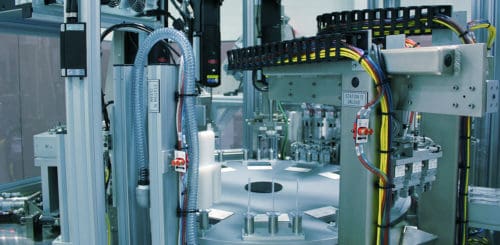
The product, when pressed together, is about an inch in diameter and three inches long. Both the top and the lower housing come in two geometric variants and several different colors. Orientation of the parts are critical to downstream processes.
ATC designed and built a line with four stations positioned around a main conveyor loop. In order to meet cycle time, screw feeders transfer pucks in and out of each station on the main conveyor in 400 ms, leaving 800ms dwell to perform work on the parts. Pucks are trafficked by powered gates and puck traceability data is maintained by barcode readers at every station. Six completed assemblies are offloaded every 1.2 seconds to a tray management system for further processing by the plant.
Station 1 orients and places lower housing to the main conveyor. The lower housings are fed using vibratory feeders. A machine vision image is taken to determine orientation. During transfer to the next position, stepper motors integrated into the transfer nest orient the parts independently to the proper radial position oriented lower housings are placed onto an asynchronous queue.
Next step at Station 1, a cam motion is used to complete the placement of the lower housing to the pucks on the main conveyor. Two servos acting in tandem lower to drive cam followers along a path to pick a lower housing from the asynchronous queue while simultaneously placing lower housings to the pucks on the main conveyor. When the cylinders raise, the lower housings are “handed off” and their orientation is flipped vertically between the two grippers so that when lowered again, the process can start all over.
Once loaded, pucks containing lower housings are indexed out of the screw feeders triggering a machine vision system to take and evaluate images “on the fly.” These images measure the height of the lower housing, checking for missing or extra material from the molding process. This system, measuring six parts in 400 ms, can find height abnormalities of less than 20 microns. For reference, a single grain of table salt is 100 microns in diameter, a human hair is 70, and the smallest thing the human eye can see is about 40 microns.
As the pucks leave the station, a barcode scanner reads the 2D Data matrix codes on the top of every puck and associates the part presence and pass/fail data of the part with the puck, again, “on the fly”.
The pucks travel to Station 2 on the main conveyor where the tops are assembled. Multiple screw feeders feed and precisely locate pucks along the entire length of this station. A prefeed screw loads eight pucks in one second, ready for top placement. The other two screws run together, locating and feeding pucks from the top placement position to the top press position in one motion. Tops are fed eight up to this station using two vibratory l feeders. Because of a distinguishing feature on the side, this part can enter an escapement in a known orientation. A servo-controlled gripper escapes the parts from the vibratory inlines and sets the caps onto the lower housings.
The pucks are indexed to the press position where color vision sensors take an image and determine if the correct color and geometry variant of the top has been placed. Servo presses push the top onto the lower housing and the force and distance profile of each press is monitored to ensure the max/min forces and distances are within customer specification. As pucks are indexed, barcodes are scanned and pass/fail data gathered at the station is associated with the correct puck.
Screws are again used for positioning to Station 3 – Reject. A barcode reader scans the puck barcodes as they are entering the station and determines if each puck contains a good part, a bad part, or no part. A high-speed pick and place picks the rejected parts from pucks and places them to the reject bin. Pucks are indexed for conveyance to the good part offload station.
At Station 4, screws index six pucks at the offload and a barcode scanner scans the pucks to distinguish between empty pucks and pucks with good parts. A high-speed pick and place deposits parts to the good part offload chute where they will end up in a tote or Quality Audit bin for offline inspection.
ATC attributes their success in the medical field to building long lasting relationships with their employees and customers with an emphasis in teamwork and pride in workmanship.
To contact ATC for your next project call 931-528-5417or visit atcautomation.com/
